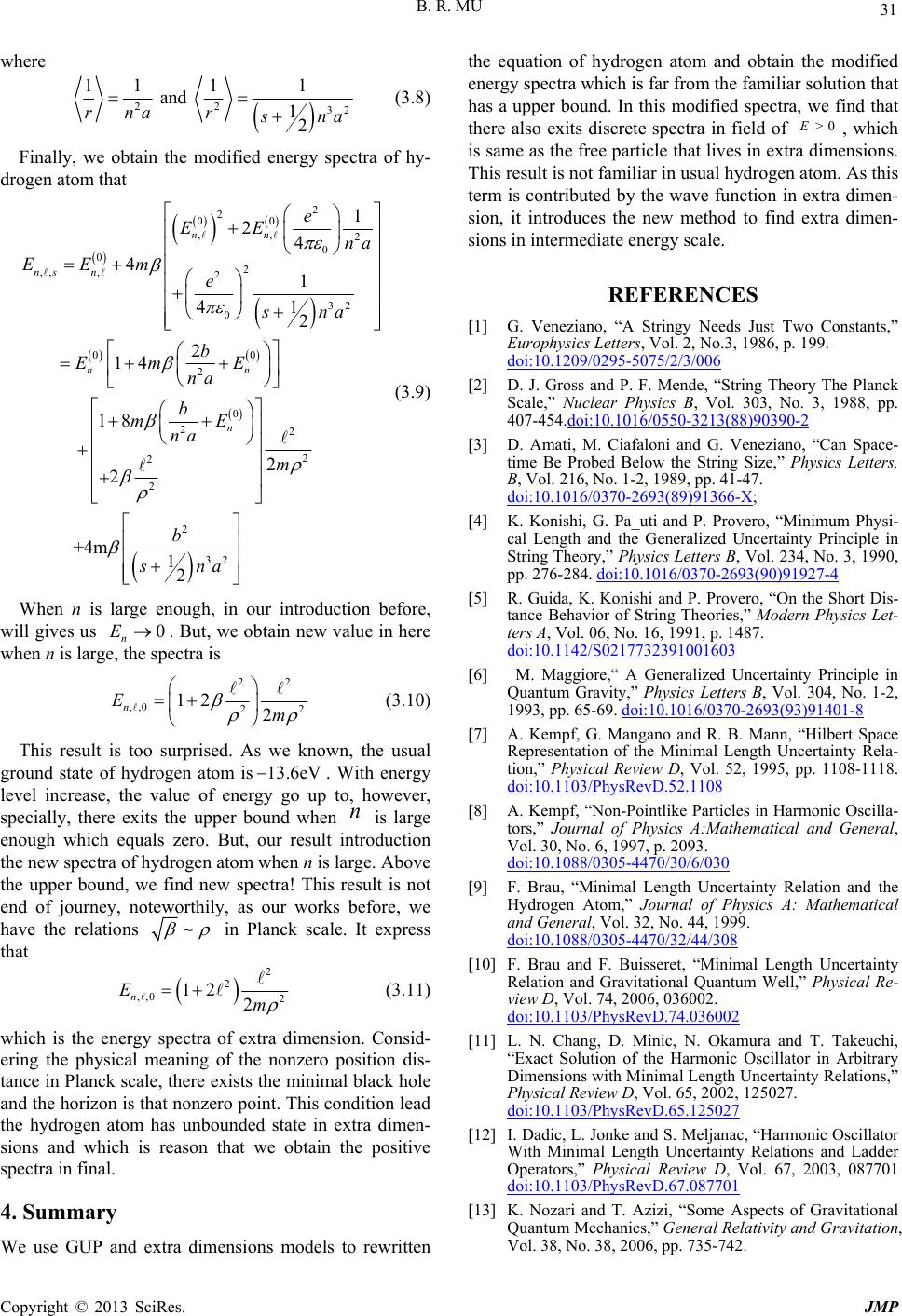
B. R. MU 31
where
22 32
11 11
and 12
rna r
na
(3.8)
Finally, we obtain the modified energy spectra of hy-
drogen atom that
2
2
00
,, 2
0
02
,, ,2
32
0
00
2
0
22
2
2
2
2
3
1
24
41
1
42
2
14
18
2
2
+4m12
nn
ns n
nn
n
e
EE na
EEm e
sna
b
Em E
na
b
mE
na
m
b
sn
2
a
(3.9)
When n is large enough, in our introduction before,
will gives us . But, we obtain new value in here
when n is large, the spectra is
0
n
E
22
,,02
12 2
n
Em
2
(3.10)
This result is too surprised. As we known, the usual
ground state of hydrogen atom is. With energy
level increase, the value of energy go up to, however,
specially, there exits the upper bound when is large
enough which equals zero. But, our result introduction
the new spectra of hydrogen atom when n is large. Above
the upper bound, we find new spectra! This result is not
end of journey, noteworthily, as our works before, we
have the relations
13.6eV
n
in Planck scale. It express
that
2
2
,,0 2
12 2
n
Em
(3.11)
which is the energy spectra of extra dimension. Consid-
ering the physical meaning of the nonzero position dis-
tance in Planck scale, there exists the minimal black hole
and the horizon is that nonzero po int. This condition lead
the hydrogen atom has unbounded state in extra dimen-
sions and which is reason that we obtain the positive
spectra in final.
4. Summary
We use GUP and extra dimensions models to rewritten
the equation of hydrogen atom and obtain the modified
energy spectra which is far from the familiar solution that
has a upper bound. In this modified spectra, we find that
there also exits discrete spectra in field of >0
, which
is same as the free particle that lives in extra dimensions.
This result is not familiar in usual hydrogen atom. As this
term is contributed by the wave function in extra dimen-
sion, it introduces the new method to find extra dimen-
sions in intermediate energy scale.
REFERENCES
[1] G. Veneziano, “A Stringy Needs Just Two Constants,”
Europhysics Letters, Vol. 2, No.3, 1986, p. 199.
doi:10.1209/0295-5075/2/3/006
[2] D. J. Gross and P. F. Mende, “String Theory The Planck
Scale,” Nuclear Physics B, Vol. 303, No. 3, 1988, pp.
407-454.doi:10.1016/0550-3213(88)90390-2
[3] D. Amati, M. Ciafaloni and G. Veneziano, “Can Space-
time Be Probed Below the String Size,” Physics Letters,
B, Vol. 216, No. 1-2, 1989, pp. 41-47.
doi:10.1016/0370-2693(89)91366-X;
[4] K. Konishi, G. Pa_uti and P. Provero, “Minimum Physi-
cal Length and the Generalized Uncertainty Principle in
String Theory,” Physics Letters B, Vol. 234, No. 3, 1990,
pp. 276-284. doi:10.1016/0370-2693(90)91927-4
[5] R. Guida, K. Konishi and P. Provero, “On the Short Dis-
tance Behavior of String Theories,” Modern Physics Let-
ters A, Vol. 06, No. 16, 1991, p. 1487.
doi:10.1142/S0217732391001603
[6] M. Maggiore,“ A Generalized Uncertainty Principle in
Quantum Gravity,” Physics Letters B, Vol. 304, No. 1-2,
1993, pp. 65-69. doi:10.1016/0370-2693(93)91401-8
[7] A. Kempf, G. Mangano and R. B. Mann, “Hilbert Space
Representation of the Minimal Length Uncertainty Rela-
tion,” Physical Review D, Vol. 52, 1995, pp. 1108-1118.
doi:10.1103/PhysRevD.52.1108
[8] A. Kempf, “Non-Pointlike Particles in Harmonic Oscilla-
tors,” Journal of Physics A:Mathematical and General,
Vol. 30, No. 6, 1997, p. 2093.
doi:10.1088/0305-4470/30/6/030
[9] F. Brau, “Minimal Length Uncertainty Relation and the
Hydrogen Atom,” Journal of Physics A: Mathematical
and General, Vol. 32, No. 44, 1999.
doi:10.1088/0305-4470/32/44/308
[10] F. Brau and F. Buisseret, “Minimal Length Uncertainty
Relation and Gravitational Quantum Well,” Physical Re-
view D, Vol. 74, 2006, 036002.
doi:10.1103/PhysRevD.74.036002
[11] L. N. Chang, D. Minic, N. Okamura and T. Takeuchi,
“Exact Solution of the Harmonic Oscillator in Arbitrary
Dimensions with Minimal Length Uncertainty Relations,”
Physical Review D, Vol. 65, 2002, 125027.
doi:10.1103/PhysRevD.65.125027
[12] I. Dadic, L. Jonke and S. Meljanac, “Harmonic Oscillator
With Minimal Length Uncertainty Relations and Ladder
Operators,” Physical Review D, Vol. 67, 2003, 087701
doi:10.1103/PhysRevD.67.087701
[13] K. Nozari and T. Azizi, “Some Aspects of Gravitational
Quantum Mechanics,” General Relativity and Gravitation,
Vol. 38, No. 38, 2006, pp. 735-742.
Copyright © 2013 SciRes. JMP